
VIRTUAL EXHIBITION
TERRITORIES
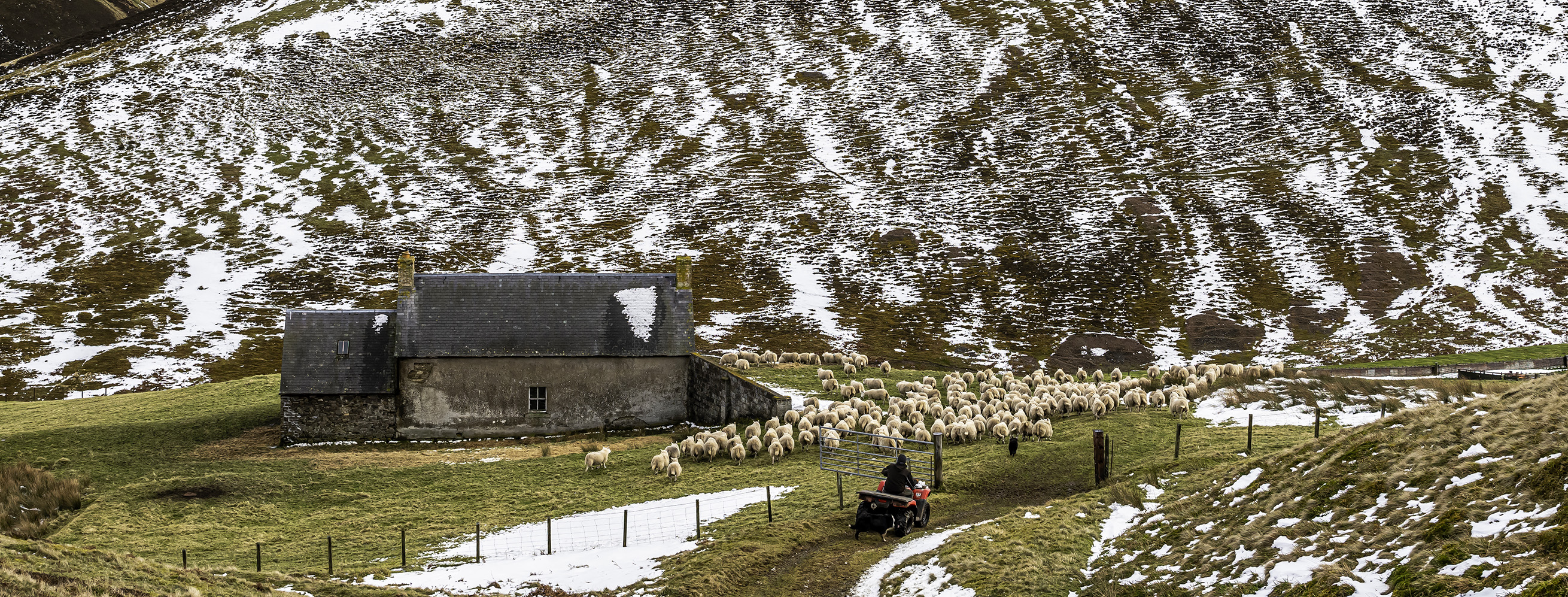
Title: Gathering sheep; Year: 2023; Place: Cheviot Hills, Scotland; Author & Copyright: Chris Strickland (www.photographerchrisstrickland.com).
What defines a territory? In the case of the Cheviot Hills, shared landscapes, farming traditions and social ties give coherence to an area which lies on both sides of the border between Scotland and England.
The landscapes of the Cheviots are renowned for their peace and quiet, and apparent remoteness and isolation. But these open landscapes are not simply ‘natural’ or ‘wild’. Instead, they have been shaped over time by pastoral farming and its ever-evolving local knowledge, making them home to a distinctive farming tradition which is well adapted to both climate and terrain.

Title: Location of the project study area in the northern Cheviot Hills; Year: 2023; Place: Cheviot Hills, Scotland and England; Author: Tudor Skinner; Copyright: Durham University.

Title: The ‘Stob Stones’, which may have been set up in the medieval period to mark the border between Scotland and England as it passes through the Cheviot Hills; Year: 2022; Place: Cheviot Hills, Scotland and England; Author: Chris Dalglish; Copyright: York Archaeological Trust.
Archaeological records, maps and historical documents, together with the testimonies of those who have worked here in more recent memory, highlight the fragility and quality of the living hill farming tradition and the lessons that it might hold for the future vitality of upland rural communities and for action on the climate and nature crises.
Here there is an opportunity to learn from the knowledge built up by experience and passed down through the generations. The deeplyrooted skills and practices of the Cheviot hill farming tradition could be the basis for ecological transition and sustainable land use in the future, for the benefit of farmers, local communities and, more widely, people and nature in the face of the very present threat of climate change.
HEFTS
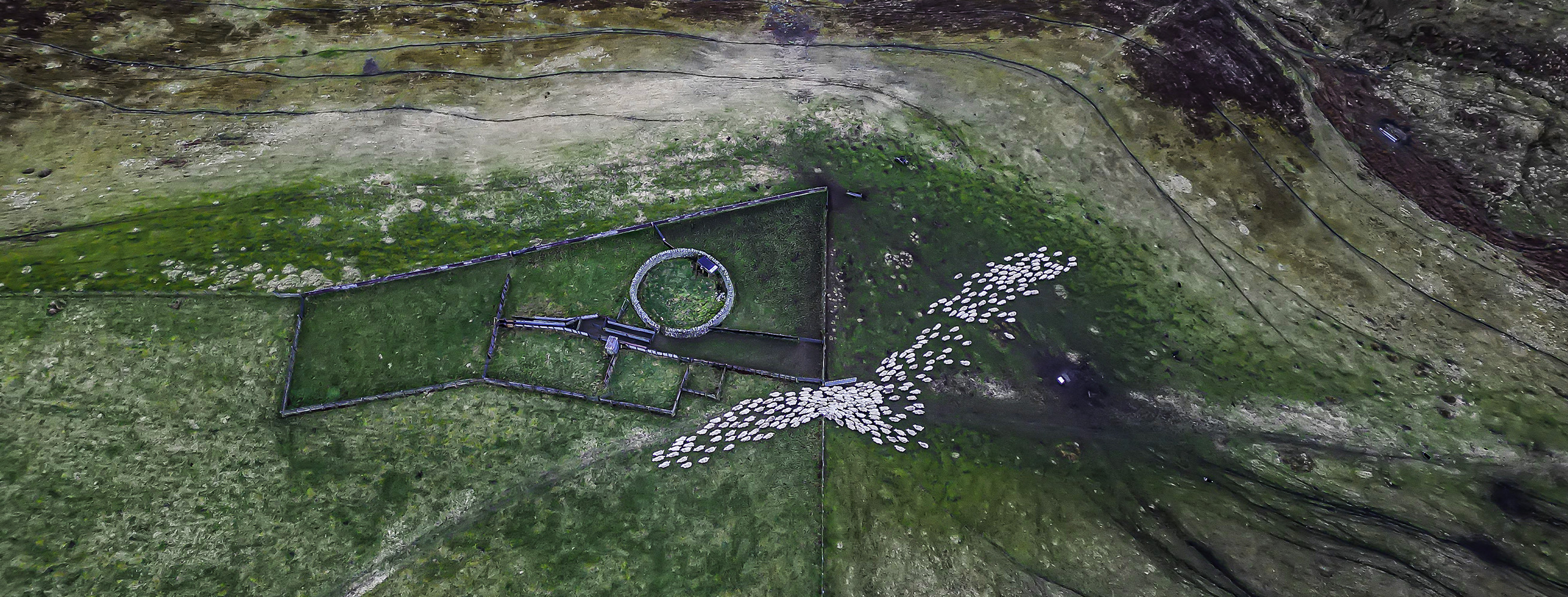
Title: Gathering sheep; Year: 2023; Place: Cheviot Hills, Scotland; Author & Copyright: Chris Strickland (www.photographerchrisstrickland.com).
Hill farming has been practised in the Cheviot Hills for centuries and there are deep connections between people, animals and the ecosystem. Among the defining traits of this living heritage are the hardy hill sheep – the Cheviot, Scottish Blackface, and Swaledale breeds – which are capable of surviving high in the hills all year round, even in the winter.
These sheep are able to graze over large, unfenced open areas thanks to an ancient practice of stock management called hefting, which makes use of the natural herding and homing instincts of the breeds. Hefted sheep tend to stay together in the same hill area (heft) throughout their lives. This intuition is passed down from the ewes to the lambs so that the sheep get to know their terrain and learn where the good grazing is, which are the best routes back to the farm and how to find shelter in bad weather, while developing resistance to particular parasites, mineral deficiencies and the plant toxins of their pasturing areas.
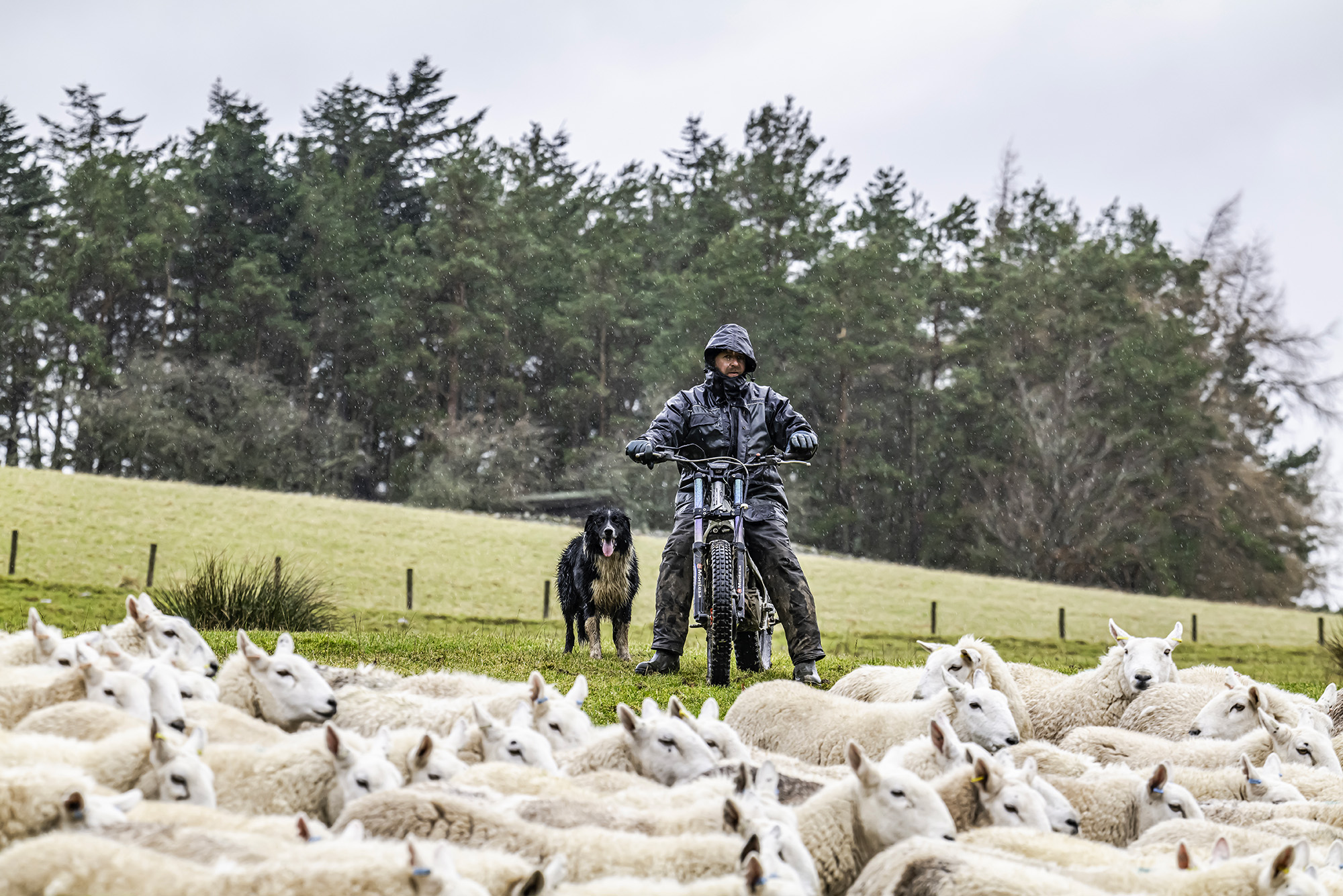
Title: Farmer with Border Collie sheep dog; Year: 2023; Place: Cheviot Hills, Scotland; Author & Copyright: Chris Strickland (www.photographerchrisstrickland.com).
Shepherd dogs, typically Border Collies, are an essential part of the local pastoral system, as – alongside the farmers and shepherds – they are the main actors in herding and driving the sheep. They are at the same time part of the farming community’s collective identity and a source of great pride amongst farmers and shepherds.
The dogs help to manage the sheep throughout the year. Traditionally, sheep were moved within their hefts on a daily basis, and this still takes place on some farms today with perceived benefits for both sheep and the land. This form of stock management requires an intimate knowledge of the landscape which can only be built up through experience. The dogs also play an important role in major seasonal tasks, such as bringing the sheep down from the high pastures to the valley floors in the spring, when they give birth to lambs, and gathering up the lambs in the autumn, when many of them are sold on to lowland farms to be fattened on better quality forage for the market.
VALUE

Title: A flock of Cheviot breed sheep; Year: 2023; Place: Cheviot Hills, Scotland; Author & Copyright: Chris Strickland (www.photographerchrisstrickland.com).
Local knowledge and land use traditions play an important role in community livelihoods and in responses to the nature and climate emergencies. Hill farming is still the economic basis of life in the Cheviot Hills, as it has been for centuries.
The hill farms are the backbone of the country’s sheep industry, because their primary purpose is to breed high quality lambs which they supply to farms across the United Kingdom. In doing this, they not only contribute to the wider food system but also maintain the genetic diversity of the sheep population.
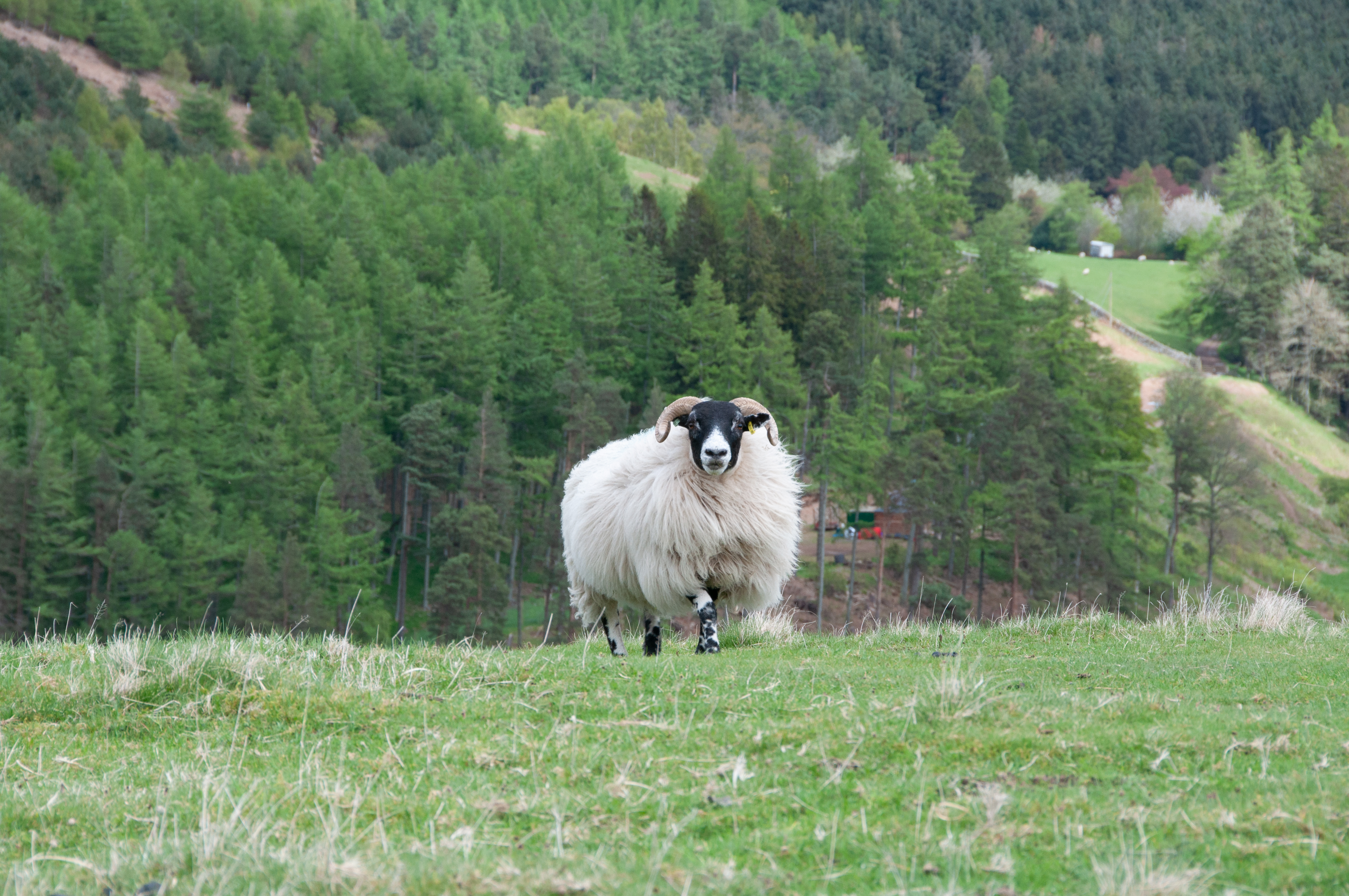
Title: Swaledale breed of sheep, Breamish Valley; Year: 2023; Place: Cheviot Hills, England; Author: Skye McAlpine Walker; Copyright: York Archaeological Trust.

Title: Farms and hefts in the College and Harthope Valleys; Year: 2023; Place: Cheviot Hills, Scotland and England; Author: Tudor Skinner; Copyright: Durham University.
The living heritage of Cheviot hill farming is also recognised for its ‘high nature value’, contributing to nature conservation and action on climate change. The moderate grazing of hill pastures – and the maintenance of upland hay meadows, which only exist because of traditional farming practices – create habitats which benefit many kinds of insects, plants and birds. Traditional grazing practices can help to tackle climate change and its impacts, for example by locking carbon in the soil and reducing flood risks.
For these benefits to be realised, the priorities are to maintain the balance of the Cheviot Hills farming system, preventing both its abandonment and its intensification, and to support farmers to maintain or revive traditional practices.
REVITALISATION
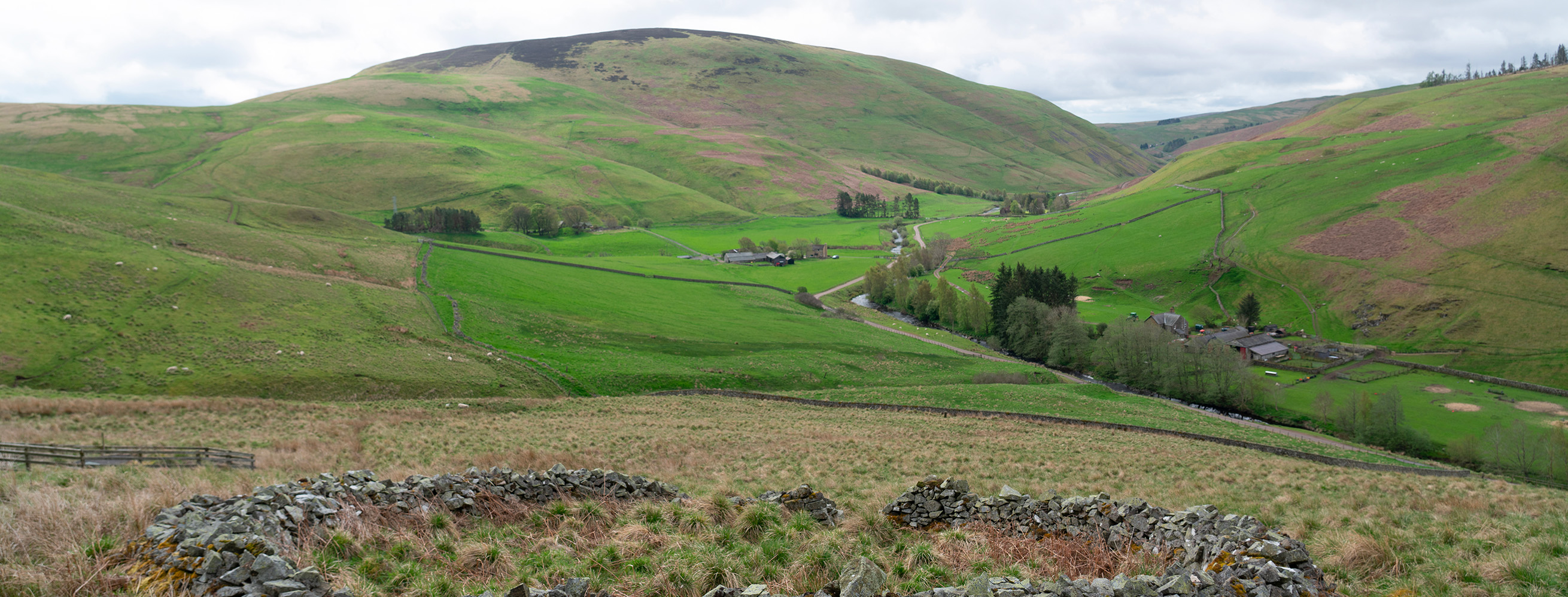
Title: Looking down Coquetdale, with an old ‘stell’ (sheep shelter) in the foreground; Year: 2023; Place: Cheviot Hills, England; Author: Chris Dalglish; Copyright: York Archaeological Trust.
The communities and landscapes of the Cheviot Hills have changed significantly since the mid-20th century, as the amount of land available for farming has been reduced by the expansion of commercial forestry and game bird shooting.
In response, sheep grazing on remaining pastures has either intensified or sheep numbers have been reduced to make way for other land uses, trends which have also been driven by European and United Kingdom agricultural policies. In places, less labour-intensive styles of farming have emerged and, with population decline, social and cultural life in the upland valleys has inevitably been eroded; schools have closed and there are fewer opportunities for young people to make a living on the land.

Title: Species rich upland hay meadow, Barrowburn Farm; Year: 2023; Place: Coquetdale, England; Author: Chris Dalglish; Copyright: York Archaeological Trust.

Title: Sheep near a ‘stell’, or sheep shelter, in the hills; Year: 2023; Place: Cheviot Hills, Scotland; Author & Copyright: Chris Strickland (www.photographerchrisstrickland.com).
But there are ways for new life to be breathed into traditional hill farming and the communities and landscapes it has long supported.
More systematic, long-term and widespread support could sustain and revitalise this living heritage, enabling hill farmers and shepherds to pass on their knowledge and skills through training, apprenticeships and practical education in sustainable land management, projecting this territory into the future and helping its communities to thrive.